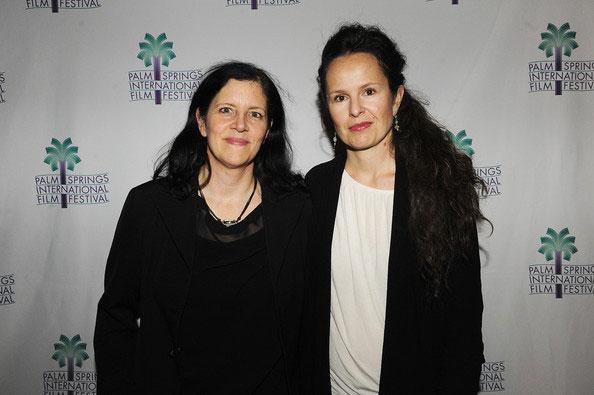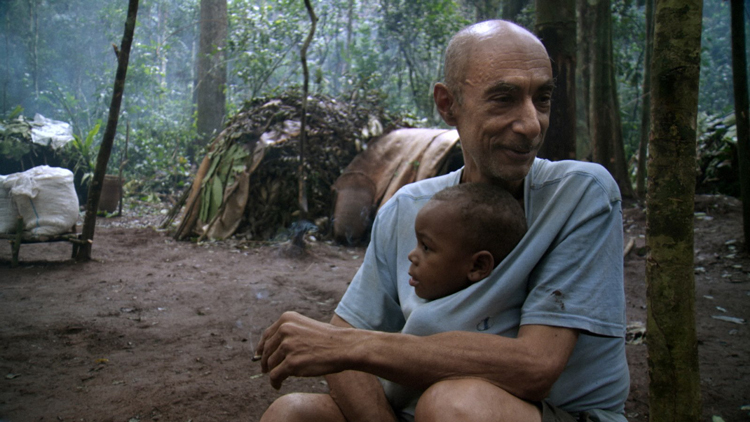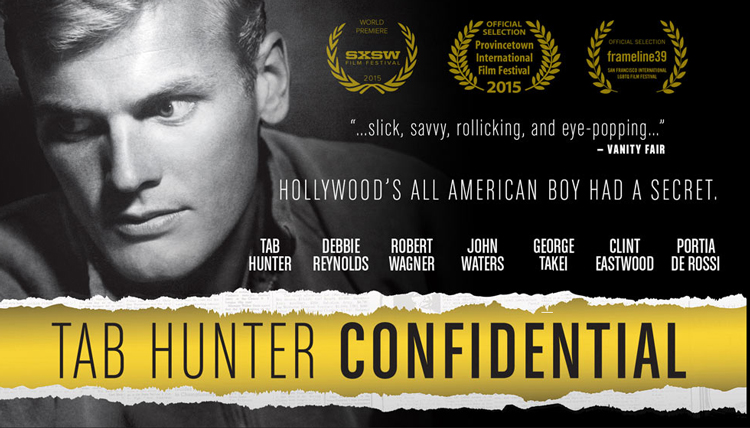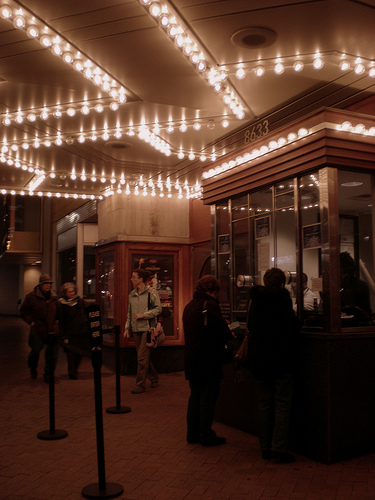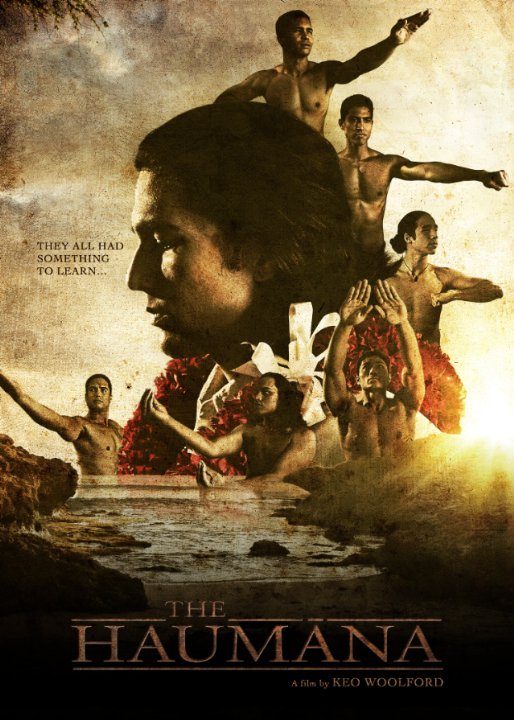
How viable is DIY Digital Distribution? The Case Study of Tab Hunter Confidential
David Averbach is Creative Director and Director of Digital Distribution Initiatives at The Film Collaborative.
When distributing your film, a lot of time is spent waiting for answers. Validation can come only intermittently, and the constant string of “no”s is an anxiety-ridden game of process of elimination. Which doors open for your film and which doors remain closed determines the trajectory of its distribution, whether it’s festival, theatrical, digital, education or home video (until that’s dead for good).
I work with filmmakers, way down-wind of this long and drawn-out process, who, after exhausting all other possibilities, have “chosen” DIY digital distribution as a last resort.
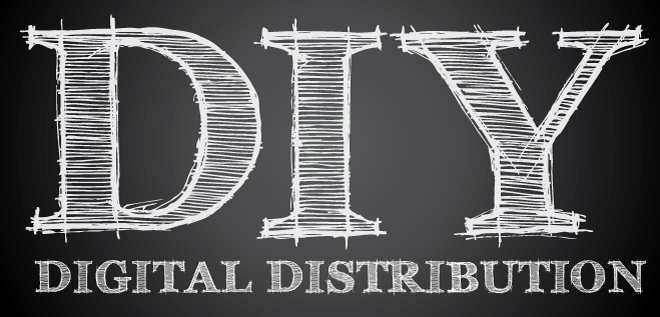
TFC’s DIY digital distribution program has helped almost 50 filmmakers go through the process of releasing their film digitally over the past 5 years and with most of them, I have often felt as though I were giving a pep-talk to the kid who got picked last for the dodgeball team. “Hang in there, just stick to it…you’ll show them all.”
Is DIY Digital Distribution anything more than a last resort? Perhaps not…
DIY vs. DOA
Since TFC was formed over six and a half years ago, we have optimistically used “DIY” as a term of empowerment, where access and transparency had finally reached a point where one could act as one’s own distributor. After all, we tell these (literally) poor, exhausted filmmakers, “no one knows your film better than you do”, so “no one can do a better job of marketing it.” With a little gumption, a few newsletters and handful of paid Facebook posts, you, too, might prove all the haters wrong and net even more earnings than Johnny next door who sold his film to what he thought was a reputable distributor but never saw a dime past the MG (minimum guarantee) in his distribution agreement. We even wrote two case study books about it.
It’s not that I’m being untruthful with these filmmakers. Nor is it the case that these films are necessarily of poor quality. What they have in common is a lack of visibility. Most had some sort of festival run, and only a handful were released theatrically, usually with one- or two-day engagements in a handful of cities. Occasionally, we’ll get a film that has four-walled in New York or Los Angeles for a week. Or sometimes ones that have played on local PBS affiliates or even on Showtime. But their films are not even close to being household brand names. So without the exposure or the marketing budget, they can do little more than to deliver their film to TVOD platforms like iTunes and hope for the best.
So what happens to these films? The news, as a whole, is not good. Based on what I’ve seen from these films in the aggregate, and all things being equal, if you DIY/dump your film onto only iTunes/Amazon/GooglePlay with moderate festival distribution but no real money left for marketing, you will be lucky to net more than $10K on TVOD platforms in your film’s digital life.
And the poorer the filmmaking quality of your film, or the less recognizable the cast, or the less “niche” your film is, the more likely it will be that you won’t even earn much more revenue than what is required to pay off the encoding and delivery fees to get your film onto these platforms in the first place (which is around $2-3K).
Which is why, as of late, I’ve been aggressively suggesting to filmmakers that holding off on high profile TVOD platforms and instead trying to drive traffic to their websites and offering sales and rentals of their film via Vimeo On Demand or VHX, two much cheaper options, might be a better use of their limited remaining funds.
But am I down on DIY? Not necessarily.
Risky Business
Granted, there are a lot of films out there for which The Film Collaborative can do very little for in the area of digital distribution other than hold filmmakers’ hands. But what about for films working at the “next level up” from last-resort-DIY? Films who have either gotten a no-MG or modest-MG distribution offer?
Many distributors and aggregators working at this level will informally promise some sort of marketing, but many times those marketing efforts are not specifically listed contractually in the agreement. So when filmmakers ask me whether going with a no-MG aggregator is better than doing DIY, this is my answer…
It’s important to remember that, once a film is on iTunes, no one will care how it got there. And by this I mean with no featured placement, just getting it on to the platform. So, if that’s all a distributor/aggregator is doing, this is not the kind of deal that a filmmaker can dump into someone else’s hands and move on to their next project. In fact, many aggregators will send you a welcome packet with tips and suggestions on how to market your film on social media, such as Facebook. In other words, they are literally expecting you to do your own marketing. Not just do but pay for. So, it is entirely possible that all that an aggregator or distributor is doing is fronting your encoding costs, which they will later recoup from your gross earnings, but only after they take their cut off the top. And if your distributor is offering you a modest MG, you must be prepared for the possibility that that MG may be all the earnings you are ever going to see. Certainly, we have seen many, many filmmakers in this position.
So the question remains: Is DIY still too risky for all but films that have run out of options?
It’s a hard question to answer, mostly because there is no ONE answer. Undoubtedly, some films will be helped with such an arrangement and some films will not.
A View from the Other Side…
Distributors, of course, will stick to the sunny side of the street. They will tell you that DIY is too risky for the vast majority of films, and remind you that distribution is more than getting a film on to one or two platforms.
When I asked Gravitas Ventures founder Nolan Gallagher, a veteran in distribution and whose co-execs have a combined 50+ years in distribution experience, about his feelings regarding DIY, he was quick to point out that the main difference between a proven distributor and DIY is that while much of the work in DIY happens in year 1, distributors can help in year 3 or year 5 or beyond. He believes that DIY individual filmmakers will be shut out from new revenue opportunities (i.e. the VOD platforms of the future) that will be launched by major media companies or venture capital backed entrepreneurs in the years to come because these platforms will turn to established companies with hundreds or thousands of titles on offer.
This is a fair point, in theory, but I honestly cannot recall a single instance of one of our filmmakers from 2010-2013 jumping for joy over that fact that his or her distributor had suddenly found a meaningful new VOD opportunity in years 3-5, nor have we heard of any specific efforts or successes down the line. But it’s good to know one can expect this if signing with a distributor.
He also mentioned that many of Gravitas’ documentarians receive multiple 5 figures in annual revenue over 5 years after a film first debuted.
That’s nice for those filmmakers…But what about the ones that don’t? It would be ludicrous to suggest that any decent film, with the proper marketing and industry connections, can become a respectable grosser on iTunes.
By no means am I singling out Gravitas in order to pick on them in any way. For many films, clearly they do a terrific job.
But does that mean that there aren’t a handful of filmmakers that have gone through aggregators like Gravitas or other smaller distributors that many TFC films have worked with, such as The Orchard, A24, Oscilloscope, Virgil, Wolfe, Freestyle Digital Media, Breaking Glass Pictures, Amplify, Wolfe, Zeitgeist Films, Dark Sky Films, Tribeca Films, Sundance Selects, who are not entirely convinced that they were well served by their distributor? Of course not.
The Million Dollar Question…
The question I really wanted to know was more of a hypothetical one than one that assigns blame: if these so-called “borderline films” that went through aggregators/distributors had done DIY instead, how close could they have come netting the same amount of earnings in the end? Is it possible that they could have gotten more?
This is a hard question—or, should I say, a nearly impossible question—to answer, because no one has a crystal ball. But also because of the continued lack of transparency surrounding digital earnings, despite initiatives like Sundance Institute’s The Transparency Project, and because the landscape is continually evolving.
A recent article in Filmmaker Magazine, entitled “The Digital Lowdown,” discusses how independent filmmakers struggle to survive in an overcrowded digital marketplace and “admits” that niche-less festival films will only gross in the range of $100K-$200K, and that, in fact, talks about a “six-figure goal.” But in almost the same breath, there is a caveat. Sundance Artist Services warns that “…if a filmmaker spends about $100,000 in P&A to finance a theatrical run, they’re probably going to be making that much from digital sources.”
I have heard many stories of distributors and filmmakers alike, who put “X” dollars combined into P&A for both theatrical and digital only to make a similar amount back in the end. So what’s the point? If you look at distribution from the perspective of paying back investors, are a good portion of filmmakers netting close to nothing, no matter whether they do DIY or whether they gear up for a theatrical and digital distribution via a distributor? If a film does not succeed monetarily, is the consolation prize merely visibility and exposure? (Which is not nothing, but it’s not $$ either).
Sweet/Talk
A few months ago, my colleague Bryan Glick posted a terrific piece on our blog that questioned the ROI of an Oscar®-qualifying run, given the unlikelihood of being shortlisted. Bryan implies that because filmmakers like hearing “yes,” and like having their egos stroked, when publicists, publications, screening series, cinemas, and private venues all lure filmmakers with a possibility of an Oscar®, something takes over and they lose perspective at the very moment they need it most.
Could the same be true for a distribution strategy? Are filmmakers so happy to be offered a distribution deal at all that they are unable to walk away from that distribution deal, even if they suspect that it undervalues their film? And could a viable DIY option change that?
Evaluating Success with DIY
Last fall, I began to think about what a “successful” DIY digital release could look like. On the low end, we’ve heard about a magical $10K figure that I discussed above…in the context of MGs paid to Toronto official selections via Vimeo on Demand, and Netflix offers to Sundance films via Sundance Artists Services. So it would have to be at least greater than $10K. And on the high end, it would have to be at least $100K that the filmmaker gets to net over a 10-year period.
Working backwards, how can this be achieved and is it possible to recreate that strategy via DIY?
One thing that gave me hope was when my colleague Orly Ravid, acting as sales agent, negotiated a licensing low-six-figure deal with Netflix for the film Game Face, about LGBTQ athletes coming out. The film won numerous audience awards at film festivals, but had no theatrical release. Timing, as well as the sports and LGBT niche, made this film perfect for a DIY release. The only catch was the Netflix insisted on a simultaneous SVOD & TVOD window, so Netflix and iTunes releases started within one day of each other. TFC serviced the deal through our flat-fee program via Premiere Digital Services.
Lessons Learned from the DIY Release of Tab Hunter Confidential
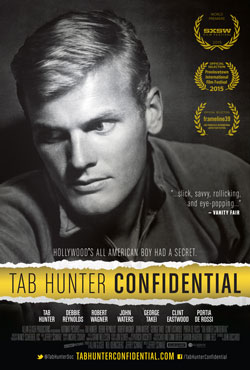 This past Spring, TFC spearheaded the digital release of Tab Hunter Confidential, a film for which we also handled festival and theatrical distribution, as well as sales. Truth be told, this film almost went through a distributor. In the end, however, after a protracted period of negotiation, an offer was made, but knowing how much Netflix was willing to offer, Orly advised the filmmaker to walk away from the deal and try our hand at a DIY release. The filmmaker agreed, and we serviced the Netflix deal via Premiere. However, as Netflix wanted the film for June, which is Gay Pride Month, we had a limited amount of time in which to do iTunes, and I was determined to make the most of it.
This past Spring, TFC spearheaded the digital release of Tab Hunter Confidential, a film for which we also handled festival and theatrical distribution, as well as sales. Truth be told, this film almost went through a distributor. In the end, however, after a protracted period of negotiation, an offer was made, but knowing how much Netflix was willing to offer, Orly advised the filmmaker to walk away from the deal and try our hand at a DIY release. The filmmaker agreed, and we serviced the Netflix deal via Premiere. However, as Netflix wanted the film for June, which is Gay Pride Month, we had a limited amount of time in which to do iTunes, and I was determined to make the most of it.
So what were the goals? And how could we get there?
I had been trolling both the “Independent” and “Documentary” sections on iTunes for months in preparation for what has now become this article on DIY. I had been noticing that while it is easy to get a film into the “New & Noteworthy” section in “Documentaries,” which contains at hundreds of films, the similar section in “Independent” is limited to about 32. So how could one get there? And how could one’s film be featured in the top carousel in “Independent” or in any of the genre categories? Would it help to offer iTunes exclusivity? Would it help to do iTunes Extras? Could we contact Apple and try and schedule something? What else could be done? These are the questions that I set out figure out on my own, or to ask our aggregator, Premiere Digital Services.
How can I get my film to be one of the 30+ films in the “Independent” Section of iTunes? This section is populated at Apple’s discretion. Their iTunes division is based in L.A., not Silicon Valley, and they attend film festivals and are very up-to-date on the indie film landscape. It’s clear, however, that while they do speak with distributors and aggregators about what’s coming down the pipeline, most of the decisions about what is to receive placement in this section occur within a week or two of the release date in question, and are decided ultimately by iTunes. I informed Premiere Digital that we were very interested in being placed in Independent, and they told me that they have weekly calls with iTunes and that—closer to the date of release—they would mention the film to them. In the end—spoiler alert—we did manage to get Tab into this section. But there were no back room deals to get that to happen…so I can hereby confirm that it is possible to be featured on the iTunes store based solely on your film and the specifics of its release.
Rotten Tomatoes Score: Out of approximately 100 films that appeared from late November 2015 to early February 2016 (which I kept track of manually, so the following is not completely scientific), about 50 of those had a “fresh” rotten tomatoes score. About 40 of those 50 had RT scores over 80%, and many of those were Certified as Fresh. Of the remaining 50 films, about 20 had “rotten” RT scores, and about 30 had no score at all. Luckily, Tab Hunter Confidential has an RT score of 87%, so I knew I was safe from that perspective. But while I was investigating, I was particularly interested in those films without a score. I noticed that many of them had star power attached, and a few of them were holiday-themed. A few of them were Lionsgate titles. And a few sports-related and horror titles, which always seem to rise to the top. I glanced at the Independent section for this week (third week in August), and these numbers pretty much bear out, save the holiday ones. The takeaway here was that if your film did not have a theatrical (and therefore perhaps does not have a RT score), if it doesn’t have famous people in it, it’s not about sports or is not in the horror genre, your chances of appearing in this section as a DIY film going through an aggregator seem pretty slim.
Check in, check out dates. As many of you know, films always end up in one of Apple’s genre sections. They stay there a few weeks or even a few months until they are bumped out of that category by newer items. But those sections are very glutted. The “Independent” section is a second placement, one that is curated by Apple, of only three rows of films. One thing that I became acutely aware of was the high turnaround in this section. Films seemed to be refreshed twice a week: once on Tuesdays (release day), and then again on Fridays. This was more or less consistent, although I got the feeling that on a few occasions things were a bit early or a bit late.
At any rate, it was very clear that if films were not pulling their weight, they would be booted from the “Independent” section for something else. At least 1/3 of the films were gone after only a few days. After all, Apple is in the business of making money off these films too. What occurred to me is that if filmmakers are doing distribution deals to get placement, and their films only last 3 days in the “Independent” section, and that measly placement is what amounts to the big perk/payoff of going through a distributor, it’s a pretty sad day for either the filmmaker, the distributor, or both.
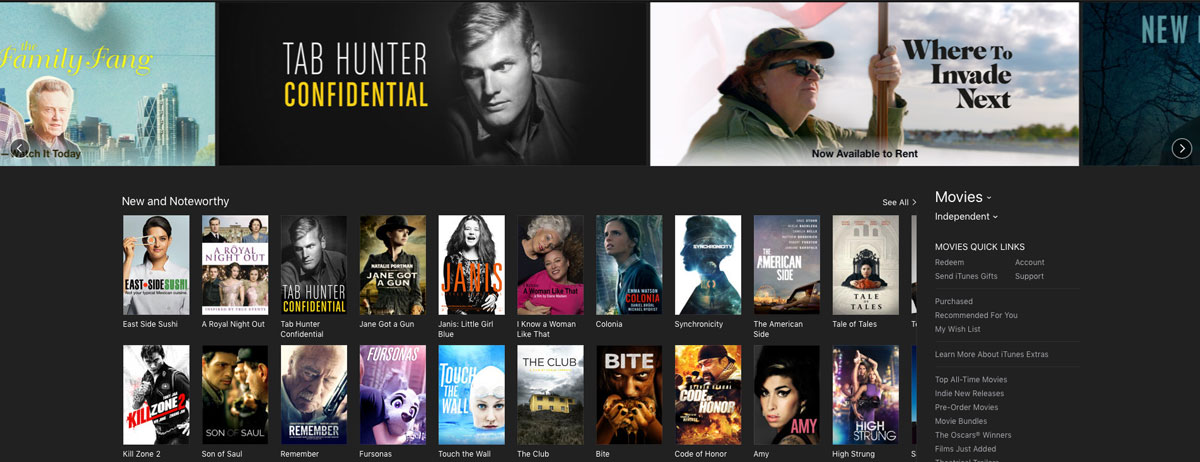
How can I get my film featured in the top carousel? It turned out to be the same answer as for the Independent section in general, but I can admit it now…I was a pest: I asked multiple people at Premiere this question. I was told over and over that Apple will make a request for layered artwork if they are interested in featuring the film. Two weeks before the release date I had not heard anything. But less than a week before, Premiere received the request for artwork from Apple. We ended up being featured in both the “Independent” and “Documentary” sections.
Why did they pick us? I am not completely sure, but here are my guesses: We had a great film festival run. The film was based on a bestselling book. We had a high RT score; we did a 40+ city theatrical; we had a lot of press, and we had a publicist; the film was apparently not doing terribly in the iTunes Pre-Order section, Tab Hunter did many interviews when the theatrical came out; Tab Hunter is freaking Tab Hunter; the film spans both LGBT genres and the genre of women of a certain age who came of age in the 1950s and still remember Tab’s poster on their bedroom walls; the artwork was classy; it was almost June; we gave them an exclusive (although I don’t think they ever advertised it as such); we did an international release on iTunes (we were told that Apple likes films to have more than one territory to be featured, which is kind of strange, because it wasn’t featured in any other iTunes store, like Canada or UK); and lastly, we did some iTunes custom artwork and iTunes Extras.
Walking the walk. Speaking of customization, one thing that I noticed about every film in the “Independent” section was that most detail pages contained customized promotion background artwork. Apple likes this. It gives the film branding, credibility. Apple has two different kinds of background art one for the iTunes store and one for AppleTV. We opted to do just the iTunes store art, which is an extra $75 conformance fee at Premiere. We also did iTunes Extras basic package, for about $700 extra, which offers a chance to include bonus features, such as outtakes and other exclusive video. Since we were planning on including bonus interviews on our DVD, we included that file, as well as 10 minutes of interviews for which iTunes is the only place that they are available. I’m not sure if Extras helped the featured placement, since we were literally down to the wire on having them appear on the store in time for the release. (At the last minute, we needed a looping background audio for iTunes, which we didn’t realize was mandatory, so if you go the Extras route, don’t forget that that audio file is needed).
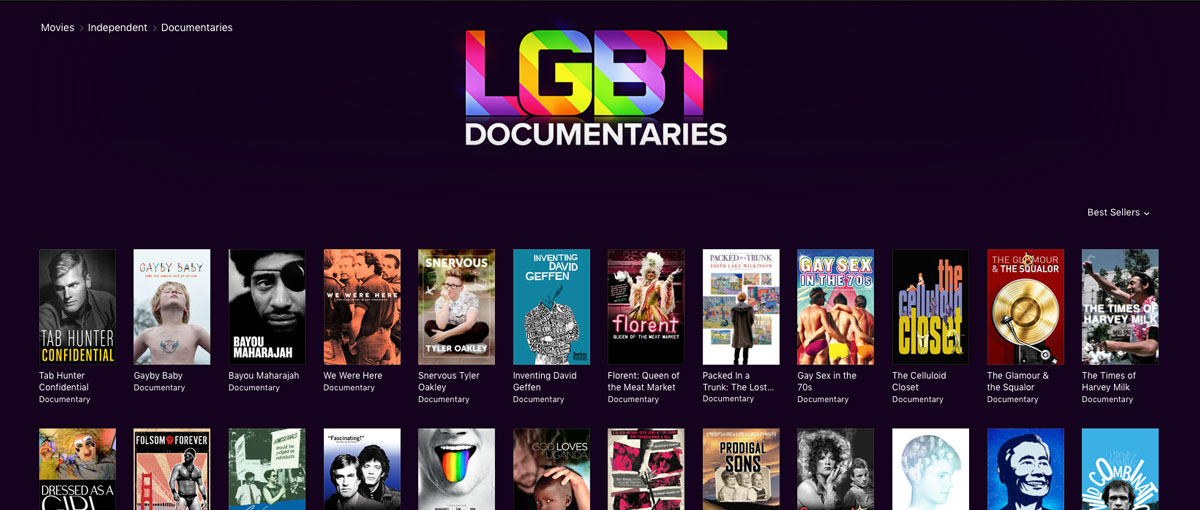
Results. All in all, we did everything we could, and it paid off. We were featured in both the carousels of the “Independent” and “Documentary” genre sections, and stayed in the “Independent” carousel for a full week and in “Documentary” carousel for two weeks. We stayed in the “New & Noteworthy” part of “Independent” for several weeks. At its peak, we reached #2 in Documentaries, being surpassed only by Michael Moore’s Where to Invade Next, which months later is still in the “New & Noteworthy” part of “Independent.” We made sure Tab Hunter Confidential shows up in both the iTunes Extras section and the “LGBT Movies” Collection section. The more places to find the film, after all, the more chance of it being rented or purchased.
After over 3 months, around the third week of August, Tab Hunter Confidential was the 12th All-Time Bestselling LGBT Doc in the iTunes store. As of the date of this blog, it has dipped down the 14th. It is still in the “New & Noteworthy” part of “Documentaries,” although to be fair that section contains hundreds of films.
Regrets? Could we have stayed longer in the iTunes carousels? Two things worked against us. First, although there was a social media push when the film was released, it was pretty limited, as we had only a small P&A budget. With more of a spend, we could have gotten more attention during the second week, and perhaps sales would have warranted the film sticking around for longer. Other films, such as Gravitas’ Requiem for the American Dream, for which TFC handled the Theatrical, featuring Noam Chomsky, have done a much better job surfing this wave. Fortuitous timing with Bernie Sanders, but that is a story for another day.
Although we offered TVOD exclusivity to Apple until June, it was unclear whether they really cared about that, as they never promoted it as such, and we probably should have released on Amazon, GooglePlay and Vudu on the same day as iTunes.
(Speaking of Amazon and GooglePlay, I once asked someone who used to work at Premiere how one gets featured on those other platforms’ stores. What they told me was shocking: Amazon and GooglePlay basically copy content ideas from the iTunes store. This was about a year ago, so who knows if this is still happening, or if it was even true at all. But I was kind of blown away by this.)
Conclusion. There are undoubtedly things one could immediately try and recreate from the steps that were taken with Tab Hunter Confidential. However, who is to know if they could work a second time, with a different film and different timeframe?
I am not suggesting in this article that distribution deals are unnecessary. Many companies have a ton of industry connections and experience that one might not be able to recreate with DIY.
But in this case, the filmmaker is thrilled, and my TFC team believes that dollar for dollar, the filmmaker walked away with a guaranteed net that is more than they would have received had they taken the distribution deal that was offered to them by a distributor.
So should DIY be considered a dirty word? Only you can decide if it is right for you film. As a whole, the jury might still be out, but, at the very least, I suspect that we’re going to get more filmmakers interested in iTunes background art.
Be sure to look out for Tab Hunter Confidential, on digital platforms, and now on DVD and Blu-Ray, which have recently been released by our friends at FilmRise.
David Averbach September 6th, 2016
Posted In: Amazon VOD & CreateSpace, case studies, Digital Distribution, Distribution, Distribution Platforms, DIY, education, iTunes, Marketing, Netflix
TFC’s Film Distribution Takeaways of 2014
As 2014 draws to a close TFC reflects on five (5) film distribution lessons from 2014 in anticipation of our 5th Anniversary at Sundance 2015.
1) DIGITAL TECHNOLOGY POSITIVELY IMPACTING FESTIVAL & OTHER PUBLIC EXHIBITION DISTRIBUTION BY REDUCING COST AND HEADACHE:
As we have seen every year for several years now, we are experiencing additional technological revolution that will change our business forever. In 2014, we said adieu to the preview DVD (for festivals, distributors, exhibitors, press etc.) in favor of the online screener link. We said goodbye to the HDCAM and the final nail in the coffin of the Digibeta. We struggled with the problems of the DCP and all its imperfections and inevitability (at least for a few more years). And we are RIGHT ON THE VERGE of the greatest evolution we will experience in recent years, which will be full delivery of films for exhibition via the Internet…whether it turns out to be Vimeo or Drop Box or iCloud or other. If we can remove the SHIPPING part of the independent film business, filmmaker (and distributor) profits may greatly increase without that part of the equation. We are almost there now…
2) THE HARD-TO-ACCEPT REALITY OF MARKETING SMALL FILMS:
As much as all of us at TFC have talked about the need to identify and target niche audiences, the ones who would be the most interested and excited to see a project because it speaks to a belief or lifestyle or cause, most indie filmmakers still aren’t heeding this advice. Of the consultations I had this year, most were with filmmakers who made micro-budget dramas with no notable names and were without prestigious festival accolades. They still believed a distributor would be willing to take on their project and give it a full release. Even those who realized this wasn’t going to happen found the financial burden associated with the kind of release they envisioned too difficult to bear, especially because they were likely to never see that money again (hence why distributors weren’t willing to take on the burden).
If you’re going to work small, you need to think small, but deep. You NEED a small, but highly passionate audience that you can reach given the resources and assets you have. Their enthusiasm will help you if you can harness their attention early on. I won’t say this is easy, but before you embark on a project that could take thousands of dollars and years of your life, first think about how you will approach the audience for your work and how you will maintain it on a consistent basis. If you think someone else is going to take care of that for you, you haven’t been paying attention to the shifts in the indie film marketplace.
If you think someone else is going to [attract and maintain a niche audience] for you, you haven’t been paying attention to the shifts in the indie film marketplace.
3) WHEN BROADCASTERS WANT STREAMING RIGHTS – WHAT TO DO?:
Increasingly, broadcasters are seeking streaming rights along with traditional TV broadcast rights and they have holdbacks on streaming and SVOD at a minimum, and often on transactional digital (DTO/DTR) too. For sure they limit / prohibit cable VOD. As a filmmaker, you only have leverage to demand a higher licensing fee if your film is a hot commodity. Otherwise, while online (or in-app) streaming will possibly gut your transactional VOD sales, you can’t beat the reach a broadcaster can give to your film. Think very hard about turning down a broadcast deal that includes online streaming. Will your iTunes/Amazon/Google Play sales really be so much if very few people have heard of your film? iTunes and Amazon are not going to promote your film like a broadcaster would.
Then again, which broadcaster is it? How big is its reach? How much publicity and marketing will you get? How much digital distribution are you barred from and for how long? Not all types of films make the same money on all types of platforms so does your film demand-to-be-owned? or is a renter, at best. Not all platforms will even accept all films (e.g. all Cable VOD, Sony Playstation, Netflix). Is yours one that will digitally succeed broadly or narrowly, or at all? Will Netflix pay 6-figures like in the good ole days or a lot less, or anything? Do you have a direct-to-fan distribution strategy that you can employ in tandem so as to not need to rely on other digital platforms in the first place?
Or if you want to try it all, still, your strategy would privilege the direct sales anyway. Which is better for your goals, a film that gets national broadcast airings or a film that turns down that opportunity only to be buried in the iTunes store? Or would it not be buried? Only you can answer this as not everyone’s goals are the same and not everyone’s opportunities / potentials are the same. As we have always said, knowing your film’s ACTUAL potential and combining that with your HIERARCHY OF GOALS will help you answer these questions and decide your distribution strategy.
And while it may feel like you are giving up revenue by allowing your film to be streamed (hopefully for a limited time!) through a broadcaster’s portal, you may find this is a good career move for your next feature because people will be familiar with your work having had the opportunity to see it.
4) THE HEAVY BURDEN OF THE NARRATIVE WITH NO NAMES:
Several of us opined about the challenges facing narratives with no names.
The emerging mega strength of incredible television series available everywhere threatens narrative film even more than before, and of course, especially the smaller indie fare.
We have seen time and again how narrative dramas or comedies almost always fall flat in sales unless they have very strong names and not just C-list or B-list names. Of course there are exceptions to this rule and Sundance can be part of that, or a hot director, or simply just an exceptional break out film. But too many filmmakers look to those as the model when they are the anomaly. The pattern we, at TFC, see repeated too often is the making of a decent or good but not exceptional narrative with names that are okay but not great and then wasting time trying to make a big or even medium sale. It just does not happen. Money and time are lost and careers often not made. Again, there are exceptions, and of course certain niches such as LGBT may be one of them, but we advise discerning between passionate optimism and sheer folly.
5) TRANSPARENCY—The Kale of Film Distribution:
The big takeaway from 2014 about TRANSPARENCY is that, on the one hand, it has become a sort of new, hip standard—something cool and good, like eating kale—that more honest distributors practice and/or shadier ones pretend to because it’s more expected. On the other hand, however, we were surprised at how many filmmakers still resist it—resist sharing their data, even anonymously. And to that, all we can ask is, what are you afraid of? It’s meant to be good for the filmmaking community as a whole but maybe individually folks are scared about what the truth will bring. And some folks just want to eat bacon. We get it. Still, we encourage sharing the real data for the greater good and we will keep on working to inspire and facilitate more TRANSPARENCY.
We at TFC wish you and yours a delightful new year and we are looking forward to being even more of service to filmmakers in 2015!
Orly Ravid December 29th, 2014
Posted In: Digital Distribution, Distribution, DIY, Marketing, Uncategorized
Tags: audience building for films, broadcasters, DCP, direct-to-fan film distribution, distribution strategy, DVD, film distribution, film exhibition, Film Festivals, independent film distribution, independent film with no names, The Film Collaborative, Vimeo
Is this mic on? Stop making these well worn filmmaking mistakes
I’m back to blogging after a long (2 years!) hiatus in law school and the first thing I want to discuss is something that frustrates us about the filmmaker consultations we give. At The Film Collaborative (TFC), it is shocking how much of what we said 5 years ago when we first started the company and what we continue to say over and over again has not trickled down and stuck to filmmakers.
While we like to think that we are changing minds and getting filmmakers to be more proactive about making their own decisions regarding distribution of their films, sadly, this doesn’t seem to be the case in the majority. The same issues keep coming up (no you probably won’t be getting a 7 figure deal for distribution…no your film is not a fit for Sundance…no you shouldn’t just sign any deal that slides across the table).
Maybe you’re afraid of letting go of the notion that your job is only to make a good film and someone will buy it for big sums and you can move on fast to your next film.
Maybe you’re worried that if you cannot look an investor in the eye and say that the odds of selling and making all the film’s money back within a year or two are good, you won’t be able to make films.
Maybe you aren’t actually following any of the information currently coming out of every festival panel and industry publication about how the distribution world stands today.
But that doesn’t mean new information isn’t available and the independent film world still works like it did in 2008.
This is information we analyze daily at TFC. Clinging to the old mythology just makes it easier for distributors to cling to non-transparency in how money is made in distribution and it’s all a vicious and unsustainable cycle. You need to know the real story on how deals are structured now, what kinds of revenue is being recouped and why, and what role audience data plays in the continuation of your filmmaking career. This is not some 90’s pipe dream of make a film, reap immediate millions.
In law, they call that “willful blindness” where a person seeks to avoid liability for a wrongful act by intentionally putting his or herself in a position where he or she will be unaware of facts that would render him or her liable. It’s not pretty to see, especially after all this time of talking about properly laying ground-work for self financed distribution. It has to stop and it will eventually because someone who is willfully blind won’t be working as a filmmaker for much longer.
Of course it’s not all about money, it’s also about building your audience and having your film seen and developing your career. These are actually all quite connected, much more often than not.
Here’s a list of things we have been saying for years and keep saying. Please let this stuff stick, it’s good for you! And the more people practice it, the healthier this will be for artists and for the business in general.
Top 15 mistakes made by filmmakers that shouldn’t keep happening are:
Making a horror film and only start thinking in August about how to release it by October of the same year. If you are planning a digital release, you need about a 4-6 month lead time.
Not building community around your film until after you premiered it at a festival (or worse, completed the circuit) such that then you squandered opportunities to build buzz, demonstrate and test audience appeal, and build awareness and marketing or organizational partnerships for future release before your buzz is gone.
Not clearing music rights believing that your distributor will be happy to pay for clearance. Profit margins are already slim for distributors, so they aren’t going to outlay for this expense. Plus, it makes you look unprofessional and extremely misinformed if you don’t have all of your clearances. Plan to work with a music supervisor.
Stealing money from your marketing and distribution budget to feed your production budget even though both are needed. In fact, if you can’t market and distribute your film, you probably shouldn’t even make it. Stop with assuming you won’t need to market and distribute your film. You will at least need to build up some kind of audience awareness and it will be smart for you to start getting immediate revenue from direct distribution.
Making your first documentary largely out of stock footage, which is probably the most expensive kind of documentary you can make. Stock footage is expensive to clear and if you have no track record of success in filmmaking, it is better to steer clear of making an expensive film as your first attempt.
Making a film with no notable names, no clearly identifiable audience, and no plan for how to distribute or market the title. This is an especially bad idea if you were planning to have someone else buy it and distribute it because it has virtually no market value.
Relying on box office gross as an indicator of the commercial success of a film, and using those numbers for the business plan of your film. Box office revenue is only top line revenue, not net revenue and certainly not an indicator of profit.
Believing that MGs in the 6-7 figure range are common for films without A-list talent. Read the trades after a major festival or film market and see what MGs are paid and for what level of talent in the film. If you don’t have this level, you aren’t getting that MG.
Skipping taking good photography on set and thinking frame grabs of the cast and crew will cut it when formulating key art and meeting deliverable requirements from buyers. Here is our post on what is needed for making key art. Still images are absolutely imperative to film sales and film promotion, but also to populate social media channels. Don’t skimp on photography.
Having a 4-minute trailer. Really? Please don’t. Also related, letting your intern or the editor of your film cut your trailer. Please hire a professional trailer editor because it is that important to gaining audience interest in seeing your film.
Forgetting that artwork on digital platforms is small, not theatrical poster size. It demands clear imagery with no extra text (laurels, URLs, credit block, rating etc).
Conflating “distributor” with “aggregator” and even with “platform” – they are different, the deals will be different, your expectations should be different, etc. This leads filmmakers to make bad or incomplete decisions. See our post on distribution terms.
Many filmmakers drastically “overthink” their festival strategy, and hold back from festival invitations for fear that actions taken now will overexpose the film and hurt its chances with press and distributors later. The truth is that INACTION is the far greater danger. By all means, you should obsess about the right world and international premieres …after that, just identify the best festival opportunities in each local market and let it fly, making sure to also address the festivals that cater to your niche along the way.
Hiring a lawyer who does not know the film business to handle your film deals. Okay, that’s a shameless plug since I’m an attorney now. But truly, as much as knowing the law matters, knowledge of what can be negotiated in a film distribution deal matters so much when it comes to monetizing rights and protecting your work.
Conducting screenings of your film (test screening as well as festivals) and not having a system for collecting email contact details so you can keep in touch about the progression of the release. When will you have another chance to contact these people again? Maximize your ability to keep in contact. There are now some text to subscribe services you can use rather than pass the clipboard.
A lot of film consultants, industry bloggers, film festival panelists, and others all saying the same thing so it’s time to realize what they are telling you is true. Can you hear me? Is this mic still on? It’s time not just to hear, but to listen and follow the advice people are freely telling you. You should no longer continue to make these mistakes.
Wishing you all the good things in your filmmaking career.
Orly
Orly Ravid September 24th, 2014
Posted In: Distribution, DIY, Film Festivals, Marketing
Tags: biggest mistakes filmmakers make, film distribution, film marketing, independent film, mistakes filmmakers should avoid, Orly Ravid, The Film Collaborative
Approaching Indie Film As An Actual Business
I was speaking with a producer friend of mine this week, and she told me a disturbing (if familiar) story, with a surprisingly inspiring conclusion.
She recently exec produced one of 2014’s “bigger” independent films…which is set for theatrical release soon. They did just about everything right. The film is written and directed by a well known, highly respected auteur on the indie scene, with a long career. It stars two very well-known character actors, who are just about household names if not quite “movie stars.” The budget was modest. It premiered at one of the pinnacle A-level film festivals. There it was bought by one of the biggest mini-majors in the business, and has since sold 18 territories worldwide. Even before theatrical release, the investors have all made a significant percentage of their money back…albeit not all of it (and certainly no profit).
She was lunching with one of the films other producers recently and she asked him… “If the film grosses 1 million dollars theatrically, do you think we’ll see any more money?” He said, “probably not.” So she said, “Ok what if it grosses 3 million?” And he said “probably not.” “10 million?” “Probably not.”
She said that’s when it dawned on her…. producing and selling an independent film the traditional way (i.e. selling all rights out of a festival premiere) is simply not a business. (BOOM…head exploding). In any other business, making back a percentage of your investment is not a success story. In indie film, we shrug our shoulders and say, “Well, that’s the way it goes” and move on to the next one.
The lack of a sound business model in independent film is what we at TFC have been trying to address all along. The “old way” of producing and selling indie films is actually a shell game at best, a way of moving money from one spot to the next that is equal part a gambling game and equal part a con-job. Sure, there are a few unmitigated success stories every year…just enough to create a delusional atmosphere that casts a spell over thousands of filmmakers who think they can just make their movie and walk away as it magically finds its way into the world and fills their pockets with cash.
Anyway, it just so happens that my producer friend is currently working on a new film, and with the production schedule being the way it is, she knows for sure it won’t be done for at least another year. And after that, of course the inevitable wait for the right Festival premiere, which can take several additional months. As such, she figures that this time she has plenty of time to re-imagine the traditional model, and approach the film as an actual business. My producer friend comes from an entrepreneurial background, where she created and sold tech companies.
This time, this film, she vows, she is going to approach the distribution and marketing of the film the way she did with her tech companies in the past, and build it like an actual business. Not wait around for some other company to come in later and supposedly do it for her.
My producer friend and I plan to sit down in the next few months and have detailed conversations about what that actually looks like, but for now, I am going to use this post to outline some of the basics….and (hopefully) create the beginnings of a road map that others can follow.
NOTE: I am aware that I have been vague with the particulars of the first film mentioned in this post…which may annoy some readers. This was intentional of course, A) I don’t have permission to reveal the details, and B) the basic principals and outcomes are transferable to most every film that has received distribution offers out of a major festival in recent years.
In any case, here we go…some of my basic guidelines to approaching an independent film like the building of any other business.
1) Break down and list every source of potential revenue for the film – and plan how to capitalize on them all. This may seem self-evident, but I’ll wager this is the most overlooked of all independent distribution strategies. That’s because most filmmakers want to sell their film outright, and count on the distribution company to do all the right things. But most distribution companies only do a few things well (if any), and they will inevitably leave numerous stones unturned.
Start with a comprehensive list of every way you can see your film making money, i.e festival screening fees, domestic sales, international sales, theatrical-on-demand (i.e. GATHr or TUGG), community screenings, traditional theatrical, DVD sales at live events, other merchandising, digital downloads etc. Then figure out how many of these you can do yourself, and where you’ll need help from others.
2) Know from the beginning who your audience is – and have a strategy for how to reach them. I know, I know, this is dismaying to most filmmakers. Most filmmakers see themselves as artists first, motivated by self-expression, and actually hope that their film is for everyone, not just a select target group. But remember, just by making an independent film, you are de facto not making a film for everyone (unless you have movie stars)…since the vast majority of the global population doesn’t consume independent film on any kind of regular basis.
In independent film, niche is king AND queen, and you need to think of your target audience as your core customer base. Approach them like any business would…who am I selling to and how do I reach them? And if your core customers love your product, then they’ll tell others about it too. Think long and hard and soul search on this question…if you don’t know who your film is for, you run the risk that it will be for no-one at all.
3) Smart marketing is everything. Hollywood studios find their audiences by essentially buying them, spending vulgar multi-millions on TV ads, billboards, publicity firms to access late night TV talk shows etc….basically putting their product in front of everyone who doesn’t live in a cave. But chances are you can’t do that.
Smart marketing actually stems from question 2…who is your core audience and how do you reach them? And here’s where the important question comes…where do those people congregate such that you can actually speak to them? If you determine that your audience is “women between the age of 30 and 40,” that isn’t particularly useful because that’s too disparate to reach. Not ALL of them congregate in the same place. But if you determine there is a certain set of bloggers and websites that your audience reads and by obtaining coverage or placing ads, you can reach them there, well that’s something you can wrap your head around.
I usually advise that filmmakers start well in advance and build a big excel grid of every organization, every website, every blogger, every tastemaker, every everything they can think of and methodically reach out to them with news about their film. You usually can’t do this until you’ve actually starting shooting..so you can at least share images and teasers etc…but please don’t wait until you are finished with the film. This process takes too long… often by then it is too late.
I shouldn’t have to mention that this is of course where social media comes in as well. You want your social media strategy to start on Day One of shooting if possible. And, as always, you’ll want your social media strategy to be as interactive and engaging as possible…not just a platform for naked self-promotion.
4) Have a rigorous and vigorous approach to crowdfunding. Independent filmmaking can seem downright depressing at times…but it’s times like this we should thank our lucky stars for the relatively recent phenomenon of crowdfunding. What a miracle it is….and the best part of all….you don’t have to give the money back. Plus you are building up an audience that is motivated to see your film succeed.
These days it seems reasonable…for the right project…to launch crowdfunding campaigns in pre-production, for finishing funds, and to jumpstart your distribution, as long as you have a compelling message to impart to the world. And a great video of course… it all comes down to the video (and to a lesser extent the perks). Remember, however, that a crowdfunding campaign is hard work…its like a whole other job, which can certainly seem daunting during production. But if you don’t work hard at it…it won’t work. The good news is, if you DO work hard at it, the success rate is amazing!
5) Explore the granting world. Like crowfunding money, grant money is money you won’t have to pay back (meaning the best kind). Grant money is usually a better fit for documentaries of course, but we’ve also worked on plenty of narrative features with a theme or message that attracted grantees. Also, don’t forget that there are also (some) grants for outreach/distribution, for films with an important social message. To pursue grants, you’ll probably also need a fiscal sponsoring organization to back you, which can be The Film Collaborative or a number of other independent film non-profits. To read more about TFC’s fiscal sponsorship progam, go HERE.
6) Pre-sell as little as possible. This is a quandary for many filmmakers. You need the money to finish the film, but then when it’s finished, those rights are tied up and you can’t exploit them in a way that you’d like to. And, again, unless you have bona fide movie stars, your film will be infinitely less valuable before you finish it than when it is premiering at a major festival like Sundance etc. Time and time again I hear filmmakers say, “I pre-sold my film to x territory (usually broadcast) because I needed the money, now I wish I could just give them the money back.”
7) Parcel off your rights in as many pieces as possible. This is something that TFC’s founder Orly Ravid has specialized in….i.e. engaging as many different companies as possible to handle as many different rights categories as possible. This goes back to what I said earlier, different companies are better at different things. This “parceling” is particularly important because many all-rights holders are using many middle-men companies to get to various platforms etc. You want to be as DIRECT AS POSSIBLE with your various points of sale, cutting out as many middle-men as possible.
8) Explore Transmedia. This is admittedly difficult for the vast majority of independent, character-driven narrative features…although there are some notable exceptions. But for genre/sci-fi features this is an area rich with possibility, through games, contests, spin-off stories etc. And most often overlooked is the potential for documentaries to explore transmedia, especially since most documentaries have countless hours of footage they aren’t using in the finished film itself. And for issue-oriented docs, there is usually a wealth of other sources, both scholarly and journalistic, that can be folded into your website. For documentaries, your website should be an equal “entry-point” into the issues raised by the documentary, and should ultimately lead to more viewers/consumers of the film. That is the very essence of transmedia…multiple entry points into the larger experience.
9) Have a well-thought out strategy for digital distribution. My aforementioned producer friend was in the tech business, so her focus is on possibly creating her own portal where her target audience can download the film directly, thereby cutting out all middle-men entirely.
Nonetheless, in today’s world you have to expect (hope) that the most viewers for your film will be paying customers in the digital realm. And thankfully, just getting your film onto a few big digital platforms these days isn’t particularly difficult (to read more about the digital distribution offered by The Film Collaborative, go HERE. But here is where #2 (target audience) and #3 (smart marketing) come in most importantly….if you just throw your film onto iTunes, how is anyone going to know it’s there?
Unfortunately, there aren’t a lot of great companies you can hire that work for very little money to assist you with the marketing part. So this may be yet another job you and your team might have to do for yourselves.
10) Keep the budget as low as possible. This may seem like the most obvious point of all, and yet it is incredibly subjective. I can’t tell you how many times I cringe when hear filmmakers say “we kept our costs down…it only cost 1 million dollars!” Well, a million dollars isn’t what it used to be….and I mean that in the reverse way it is traditionally meant. With the plethora of cheap digital cameras and desktop editing leading to an explosion in independent film, supply WAY outstrips demand… and a million dollars is quite an expensive indie movie these days. Most importantly, at a million dollars chances are there is probably no amount of DIY distribution techniques that will recoup your investment, and you’ll be back in the initial quandary, meaning you will NEED a significant traditional sale from a distributor to have any chance of making most of your money back.
So, when I say keep your budget low…to be honest I am talking more like $100,000. And I know that’s not always possible. So if you can’t do it for something in the low six-figures, you’re back to that place where you need to start thinking about movie stars.
11) Put a minimum of 10 – 15% of your budget aside for marketing and distribution costs. This is a VERY small percentage of your budget that really will only enable you to start building a core audience, but a core audience can grow wider if word of mouth is active.
Again, I know this is easier said than done. Even if you line-item that with the best intentions, many filmmakers will pilfer along the way for a few extra days of shooting, etc. But chances are you’ll find yourself with a finished film with no more money to get it out into the world….no money for festival trips, no money for smart marketing, no money to hire a publicist, etc. Recognizing that even the initial stages of marketing and distribution require capital, we at TFC implore you not to fall into the trap of being cash-strapped right at the time you need it most.
Most of all of what I have outlined above fall under the producer’s responsibilities, and are sometimes referred to the work of what might be called the PMD or “Producer of Marketing and Distribution.,” and are crucial to development of a producer business model for indie film.
Interestingly, sometimes I think there is a clearer business model for directors of independent film. Directors have a clearer path to a business model that makes sense…direct an indie gem, premiere it at Sundance to great acclaim, and then get hired by Hollywood to direct commercial TV and film (think Christopher Nolan, who seemingly went directly from Memento to Batman). But producers seem to start at step 1 with every script.
It is my hope that by following the guidelines listed in this post, at least some of the groundwork to planning a profitable business model for an independent film can be laid out in advance.
Jeffrey Winter August 19th, 2014
Posted In: crowdfunding, Digital Distribution, Distribution, DIY, Long Tail & Glut of Content, Marketing, transmedia
Tags: business models, film distribution, film marketing, independent film, Jeffrey Winter, The Film Collaborative
Is VOD Collapsing The Festival Window?
Filmmakers often ask me how long they should keep their films on the festival circuit. For years now, I’ve been saying that for any film that is performing well on the circuit (meaning getting accepted into a significant number of festivals on a more or less regular basis), there is a general rule you can follow.
Most films will see their festival bookings continue robustly for 1 year from the date of the world premiere, and then significantly drop off (but still trickle in) in months 12 – 18. After 18 months, festival bookings will nearly cease worldwide, except for those films that have a perennial hook (i.e. a film about black history during the annual Black History Month, a film about the AIDS crisis on World AIDS day, etc).
Given that general rule, I am going to go ahead and call that 18 months the Festival “window.” Now, of course, most Hollywood companies don’t consider the festival circuit as a window akin to the “traditional” windows of theatrical, broadcast, DVD, VOD etc. For studios and mini-majors, a long festival run isn’t always necessary…they have the money and staff to market the film in other ways, and any potential revenue the film can make on the festival circuit is relatively meaningless given the scale of the budgets they work with. In many cases, larger distributors see festivals as really just giving away free tickets to their movie, and therefore limit any festival participation to only the largest, most prestigious and best publicized festivals in the world, and simply ignore all the rest.
But for individual filmmakers without the benefit of studio/mini-major release, and also for many small distribution companies, the festival window is invaluable and irreplaceable in terms of the marketing/publicity value it can afford, and the modest revenue that can be generated. For many films of course, the festival window IS the theatrical release of the film – meaning it’s the way the largest number of people can actually see the film in a theater. Even those indie films that do get a traditional theatrical release are usually limited to a few big cities, meaning festivals are the only way the films are ever going to be screened beyond New York, L.A., and few other cities. Since most individual filmmakers and small distributors work on a modest budget, any and all revenue the film can bring in is significant. Additionally, the free marketing/publicity that a festival offers is just about the only kind of marketing the film may ever get.
So – and this is back to the original question – when filmmakers ask me how long they should keep their film on the festival circuit if it is doing well, my initial answer is always “at least one year.” Given that you only have 12 – 18 months for your film to be seen this way, why not take advantage of it?
Filmmakers have a lot of fears around this; often they feel in a rush to get their movie available for theatrical or home purchase as soon as possible. Often they fear that people are going to “forget” about their film if they don’t release it as soon as possible after the premiere. Often they regard the festival circuit as a lot of work, and they just want their film released so they can move onto their next thing. Even more often, they are in great financial need following all the money invested into the film, so they feel the need to get it out quickly so they can start making money from it. I can say with great confidence that all of these fears are bad reasons to release a film – and many of the worst release failures I have ever seen comes from exactly these fears (both on the studio/mini-major level AND individual filmmaker level).
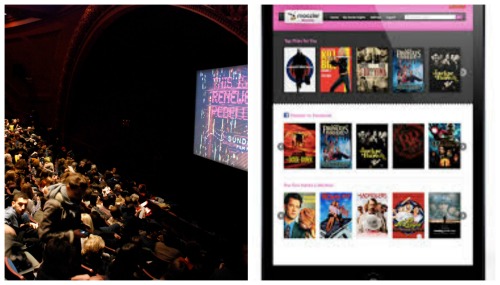
First of all, unless you’ve been extremely successful in attracting people to your social media, very few people actually know about your film when it first premieres…so rather than fear those people will forget about your film, your job is to get the film out as wide as possible so you can grow your audience awareness – both through repeated festival marketing and social media. Secondly – yes, it is true that the Festival circuit is a lot of work, but independent filmmakers need to understand that distribution is a business, and you need to commit yourself to it the way you would to any other business endeavor you would undertake and expect to be successful. A business takes time to grow.
The most vexing reason for rushing a film into release – needing to make your money back as quickly as possible – is a perfectly understandable human need and a situation many filmmakers find themselves in. I can just all but guarantee you that if you haven’t taken the time to grow your audience in all the ways possible, your release won’t succeed, and you won’t be making back your money anyway.
Despite all this – despite everything I have laid out in this post thus far – in 2014 I find more and more films going into release and off the festival circuit faster and faster than ever before. The reason for this trend is simple, technological, and perhaps inexorable – and of course it is the continuing rise of Video On Demand (VOD).
Think about how it worked in the (not so) old days. Until very recently, if your film was lucky enough to get a theatrical release offer, it would take the distributor many months to get their marketing/publicity ducks in a row, book theaters, and release the film into theaters. All this time, the film could play festivals. Then, upon theatrical release, a few cities would be lost to festivals…just the usual NY, LA, San Francisco, Boston, Seattle etc. of a traditional indie release. But for the many months between the theatrical release and the DVD release, the film could continue to play all festivals outside of the major cities…because DVD release is a physically demanding process of authoring, dubbing, shipping, shelf space, store stocking, etc. As such, it was completely normal for DVD release to be at least a year after the premiere…just because it all took time. Once the DVD was released, the overwhelming majority of festival programmers would no longer consider the film, so the festival window was all but shut at that point.
But in 2014, day-and-date VOD release with the theatrical release is commonplace, and becoming even more so. So, its not that distributors are any faster in getting the film into theaters (they’re not), but once New York and L.A. open (or shortly after), chances are that the film is also available on various VOD platforms, meaning it becomes available all at once in most North American homes (via cable VOD, application like Apple TV, or various internet platforms). And once that happens, the majority of festival programmers no longer will consider the film, believing (perhaps incorrectly) that the VOD release will cannibalize their audiences and they will no longer be able to fill their theaters with patrons willing to go to see a film at a festival when they can just watch it at home.
In addition, there is a rise in the number of cable TV channels seeking exclusive content for their VOD platforms (i.e. CNN, DirectTV, Starz, etc.) who are acquiring films with or without theatrical releases, and are in a haste to get those films out to their audiences. Exclusive content is the currency of premium platforms these days (there is no better evidence of this than the incredible success of HBO exclusive content of course), and so more and more of these companies are making offers to indie films, largely driven by the VOD.
I am not sure there is a lot independent filmmakers can do to change this trend. Filmmakers are going to continue to want distribution deals and this just may be what distribution deals look like moving forward. Of course, filmmakers can ASK that distributors put off the release as long as possible (as discussed, approx. a year after world premiere), but many distributors may not have reason to agree to that. Keep in mind that the distributor may not have complete control over that release date, in many cases the biggest VOD companies (esp. the big cable providers like Comcast, Time Warner etc.) will also tell the distributors when THEY think the film should be released, and resist the pushback…especially as they tend to want the VOD release to be closely timed with the theatrical.
That doesn’t mean I think filmmakers should cave easily….by all means try to make the distributor understand why you want to control your own festival “window.” Personally, I am consistently impressed with how much the various arms of Public Television (ITVS, Independent Lens, etc.) seem to get this, and basically allow filmmakers to set their own broadcast window relatively far into the future.
So despite my musings to this point, some of you may still be asking, “Why does all this matter? Isn’t being released into the majority of North American homes a good thing?” The biggest problem is that we simply don’t know….because VOD numbers are very rarely publicly reported, in fact almost never.
My strong suspicion is films that are rushed into VOD release perform far less on VOD than they would if they were given the time to find their audience via organic word-of-mouth methods (including festivals). I have certainly seen that with other windows, especially theatrical. As we all know now, a digital release is not enough…a film that is released into the digital marketplace without adequate marketing is just a tree falling in the forest. But ultimately I cannot support that argument with figures because so few companies (nearly none), will tell us what kind of numbers they do on VOD with their films.
Until we get real numbers that allow us to see what VOD numbers really look like for festival-driven independent films….and we can truly assess the marketing impact on those VOD numbers…we will all remain in the dark on this topic to the detriment of independent filmmakers trying to make distribution decisions. I can say for sure that films performing well on the festival circuit are forfeiting their festival revenue by going onto VOD….but until I can compare it with the VOD numbers I cannot determine whether losing that festival revenue is worth it or not.
So, is VOD collapsing the Festival window? Yes, that part is for sure, and we at The Film Collaborative have handled festival distribution on films in the last two years that bear this fact out. Is that a net negative for independent filmmakers? That part I cannot answer yet….although I suspect I already know the answer.
Let this be one more call to our Industry to release the VOD numbers. I would absolutely love to be proven wrong on this.
Jeffrey Winter June 26th, 2014
Posted In: Distribution, DIY, Film Festivals, Marketing
Tags: day and date film release, film festival distribution, Film Festivals, independent film, Jeffrey Winter, maximum time on the festival circuit, The Film Collaborative, VOD
Casting Recognizable Actors in Your Low Budget Indie Film
Today’s guest post is from Thomas Beatty, writer and co-director of The Big Ask. Beatty offers his advice about one of the things we are hearing over and over again from sales agents, the power of the “star” cast to encourage significant distribution offers. This is especially true for indie dramas that are incredibly difficult to sell without notable cast to market.
When it comes to distribution, one of the best things you can do to help your movie is to get recognizable actors with whom your audience already has a positive relationship. While I would never recommend choosing fame over talent, why not aim high and try to get that dream person who is an amazing actor and also brings an audience with them? While you may not get a legitimate movie star, that doesn’t mean you can’t get someone who is incredibly talented and make it a hundred times easier on yourself to get distribution and visibility for your movie. Below are some things that we found incredibly helpful in putting together our dream cast.
1. Write for actors.
Whether you yourself are a writer or you’re looking around for material to produce or direct, look for parts and stories that will specifically appeal to actors. Like in all endeavors, you have your best chance of being successful if everyone involved is getting something they want. On your low-budget indie, you can’t make a fair money trade, but you can give actors the opportunity to do special work and to expose their audience and other filmmakers to parts of their range they haven’t gotten to show before. I was an actor for years and am the son of an actor. I feel that one of my strengths as a writer is being able to write parts that help actors do their best work. All the performances in our movie are incredible and I hope that the script and our style of directing helped in that.
If you’re not an actor, consider reading some seminal books on acting and its different techniques. You could also ask a talented actor you know how they break down a script and consider that when choosing your story. Ask yourself if your script does everything it can to help an actor do their best work or whether it’s fighting the actors and asking them to make up for the script’s deficiencies. Is it clear what the characters want scene by scene and over the entire arc? Do they get the opportunity to really change? Actors are often great judges of material. Don’t go to them with something unless you truly believe it’s great.
The script for The Big Ask was the fifteenth or so that I had written and the first I tried to make because it was the first I thought was good enough. Beyond being good enough, I thought it would stand out as unique in the pile of scripts that most recognizable actors have in front of them.
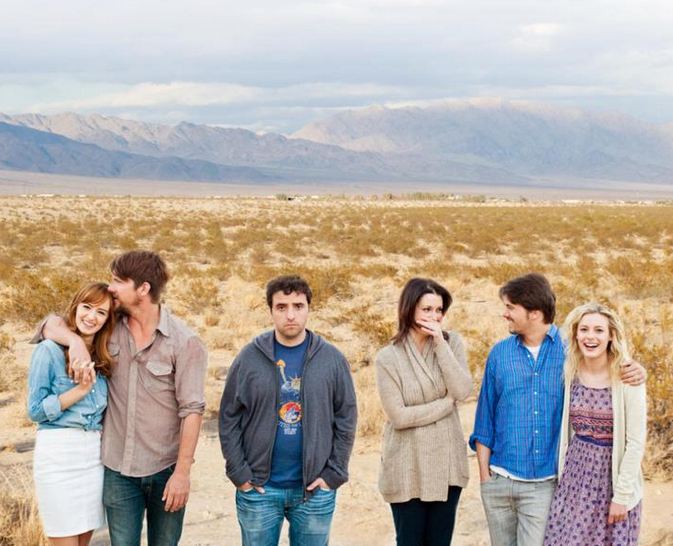
2. Find a good casting director.
Everyone wants to feel safe and supported when embarking on a creative enterprise that will leave them incredibly vulnerable. Knowing that a casting director they respect believes in the project is a huge advantage. Everyone knows they’re going to have to work incredibly hard to get the eyes of known talent on their script, but why not start with known casting talent? We got incredibly lucky when Rich Delia, then of Barden Schnee Casting, took on our script. They cast bigger, award-winning movies like Winter’s Bone and The Help and every actor knows them and respects them.
When they agreed to cast the movie within our budget constraints, it was the first, and perhaps biggest, break in our preproduction process. While it’s incredibly helpful to have a great casting director, don’t spend a quarter of your budget on a casting director that begrudgingly agrees to take you on. Make sure they believe in your movie, or they won’t give it the attention you want them to give it. No matter what, you’ll be fighting for time against other movies that are paying their salaries and their rent. Make sure they want to be working on your movie.
3. Plan your shoot around TV shooting schedules.
When deciding when to shoot your movie, take into consideration when TV shows are shooting. We shot during the second half of pilot season. Our thought was we would get people after they’d shot their pilots but before they started their season. That time is often when network shows are on leave as well. As cable channels and even networks no longer have a set season, it becomes more difficult to schedule around television work, but it’s still worth considering, especially if you have one or two principal actors. Some people also schedule their short indies during the vacation periods like Christmas, but then you run the risk of people wanting to be with their families. We had to schedule around 6 principals in our ensemble. Hopefully you will be primarily worried about one or two actors.
4. Pick specific actors with something to gain.
Part of the reason we put so much stress on TV schedules was the belief that our best chance of getting interest from more established actors would be to focus on really talented actors doing very specific things on television who might be looking to stretch their range. Gillian Jacobs does amazing work on “Community,” but is she using all the tools she learned at Julliard? At the time we were casting, David Krumholtz was just finishing the pilot for “Partners.” We’d loved watching David for years and knew that he could easily transition from a multicam to an indie. When we cast him he laughed and said “I can’t believe you gave this part to a Jew!” He then went on to thank us for believing he could carry a movie in such a dramatic role. He said that he relished the opportunity to do parts like this. Don’t be afraid to try to think from the perspective of actors and trust your intuition about which actors out there have more to offer than they’re getting to show.
In our case, working with an ensemble of other great actors was part of the appeal. But often, part of what an actor wants to show is that they can carry a movie. David certainly was the center of our movie and I know that playing the lead appealed to him. Often approaching an actor with the opportunity to be at the center of a movie and be responsible for carrying it can make your movie stand out if mostly they spend their time playing supporting roles.
There are so many things that you have to think about when putting together a small movie. It’s nearly impossible to make something even half-way good, and equally as difficult to get people to pay attention to it. Reaching high with your casting is just one thing you can do to help yourself along. While every rule in indie filmmaking is there to be broken, trying hard to cast recognizable, talented actors can only help you.

THE BIG ASK’s co-directors Rebecca Fishman and Thomas Beatty
THE BIG ASK is Thomas Beatty’s first feature film as director. He has previously shot a number of short films, and along with his writing partner, Matthew Gasteier, he is repped by UTA and has projects in development with Broken Road and Scott Stuber Productions, among others. During his five years at Lakeshore Entertainment, Beatty helped guide thirteen films from script to screen including UNDERWORLD 3 and CRANK.
THE BIG ASK is now available on various digital platforms including iTunes.
Sheri Candler May 28th, 2014
Posted In: Distribution, iTunes, Marketing
Tags: casting director, David Krumholtz, Gillian Jacobs, independent film distribution, Rebecca Fishman, Rich Delia, screenwriting for directors, star driven cast, Thomas Beatty, TV pilot schedules
A feature film about male hula dancers enjoys niche success
Written by Keo Woolford, edited by Jeffrey Winter
EDITORS NOTE: Anyone who has read the TFC blog or heard us speak in public knows that strategies for monetizing independent film through audience engagement, focused niche marketing, grassroots outreach and DIY/hybrid release techniques are the tenets of what we teach and preach. Too many filmmakers get lost in the dream that their film should be seen by everyone, so they forget to identify and target (or they willfully ignore) the core demographic for their film.
Every once in a while, however, a film comes along that grows organically from a community, and through careful nurturing by the filmmakers, manages to excite true buzz in its core audience. TFC member film THE HAUMANA, a 2013 film about a high school boy’s hula troupe by filmmaker/actor/hula dancer Keo Woolford, is a perfect model for this kind of niche DIY strategy, born from genuine community spirit.
This month on the blog, we have been advising those headed into the Winter and Spring festivals. If you still haven’t identified the core audience of your film, this post should give you something to think about.
As an actor, I’ve lived and worked in London, New York and Los Angeles. Wherever I go, I take my culture and home with me. I am a proud hula dancer and I would get a little defensive when people would flap their hands at me or ask me, “Where’s your hoop?” It was amazing to me how little people knew about hula and that men even danced hula. This perspective was coming from intelligent and esteemed circles of people, including educators at the University level.
I was blessed to have been commissioned to write and perform a one-man show, directed by Roberta Uno and supported by other sympathetic people and organizations in New York that would expose the struggle of holding on to tradition in post-modern Hawai`i, far from the misconception and misrepresentation of our culture in the global mass media. The show toured for about three years across the United States and also to Manila. Inevitably, audience members would ask if I was going to make a movie about this.
Seed planted.
Cut to a few years later, in between acting gigs, and the conception of the screenplay was born. I originally wrote the lead role for myself. But as time for production crept up, I knew it was my responsibility to oversee the project to keep my vision intact.
The screenplay and film were created for the culture I feel so proud to be a part of; the hula community, both in Hawai`i and outside of Hawai`i. It was also for the local Hawai`i population and the diaspora of Hawaiians and former residents of Hawai`i who still maintain a strong connection to their home and for the people who want to know a little bit more about our culture. It was a goal of mine to show this side of our culture from an insider’s perspective versus someone’s “idea” of what our culture is about. At the same time, I wanted to entertain the audience and not be didactic or documentary about the approach.
I won’t say too much about the budget except that this would be considered a micro-budget feature. I put up most of the money and my best friend helped me raise the bulk of the rest by getting friends to invest for producer points. We did an Indiegogo campaign, which raised a couple of thousand extra. More than anything, though, it was the generosity of the community, crew and cast that kept our budget so low. Everyone worked for reduced or base rates, and the rest of the resources, work, time and talents were enthusiastically “donated.”
This was my first venture in such an undertaking. I have no college or film school degree, and no previous experience in writing, directing or producing such a project. I just had the burning passion to show the world a little more about our culture and assumed the hula and Hawaiian community at home and at large felt the same way about seeing something like that. Therefore, although I didn’t think about it much at first, I always knew that there was a core audience I could draw on, and hoped this film would speak to them.
My initial idea was to get into all the big festivals. Deadlines were coming up quickly and I sent them unfinished versions of the film (which I will never, ever, ever do again, even if they say they accept unfinished submissions). One by one, I was denied. I didn’t mind so much. It drove me to make the film better and gave me that much more time to finish my film the way I wanted. And in the end, I realized I needed every extra minute.
Finally, a programmer named Anderson Le who works for both the Hawaii International Film Festival and Los Angeles Asian-Pacific Film Festival approached me about submitting to these two festivals [editor’s note: Hawaii International (HIFF) and LAAPFF are unquestionably two of the most important showcases for Asian/Asian-American/Pacific Islander film in North America. HIFF also includes many other kinds of cinema as well, but is particularly well known as a “gateway to Asia.” It is important to remember that many “niche” films may find better premieres in specialty festivals than in the large, generic ones.] At that point, I had really become gun shy about submitting an unfinished cut, but ended up giving him the latest version to screen. This time proved to be a charm.
THE HAUMANA was accepted into both festivals and ended up winning the Audience Award at both festivals. It made history at HIFF by being only the second film to ever sell out the 1400-seat Hawaii Theatre (the first was Crouching Tiger, Hidden Dragon) and it was HIFF’s Official Closing Night Film. We also won a Special Jury Prize for Best First Feature from LAAPFF. Since then, it has played in a handful of other film festivals and won another Audience Award at the Philadelphia Asian Film Festival and was nominated for Best Film and Best Ensemble at the Orlando Film Festival.
With the support of these festivals, the word of mouth has spread quickly. From the success we garnered at HIFF, the film was picked up for a run at a small theatrical cinema on O`ahu, where the opening weekend gross was around $10,000. It just completed it’s 9th week at the theater. It is also available On-Demand to all Hawai`i residents
The parent company of the theater in O’ahu (Pearlridge Consolidated) was so enthusiastic about the numbers that they also invited the film to open at a theater they own in New York City, the well-known Village East Cinema. I originally assumed they wanted it for a single screening, but then they told me they wanted it for a one-week limited engagement! And then it was extended for a second week! I don’t have the grosses at the moment, but hope they will give them to me soon.
In addition, the film has also been playing a combination of four-wall screenings and Gathr screenings across the county, selling out the majority of the screenings where the average net is approximately $1500-$2000 per four-wall event.
The strategy has been simple. Hit the core target audience of the film and let the word of mouth carry it even further. Wherever the film has played, the word of mouth has been incredibly strong. The community is passionate about their culture and hungry for work that represents them in a positive and authentic light. I know this, because I am one of them. I have the same passion and hunger for my culture.
Most of the marketing has come from social media. I’m almost embarrassed to say that I didn’t start a Facebook page until about a year after we wrapped principle photography! But once I realized the power of social media, I went all in and I am amazed at how quickly the word spread about the film through Facebook alone. I also have a dear friend, Tracy Larrua, who is my PR person. She has been extremely hardworking and effective in getting the news out about the film into TV and press in various forms. And I had a trailer made as a teaser and then as a 30-second TV spot that played Hawai’i for 5 weeks, which has also been well-received on YouTube.
Through Facebook, I had been getting many inquiries on our page about screenings in a bunch of locations around the world. I did some research on four-walling and once the film made it’s Hawai`i premiere, I wanted to get it out to as many places as I could. The handful of festivals the film was invited to didn’t reach many areas the inquiries were coming from, so I put up a page on our website that allowed anyone who wanted to set up a screening or fundraiser event to contact us to arrange one.
The emails flooded in. Most were from Hālau (hula schools) around the country who wanted to use the film as a fundraiser to raise awareness about hula and our culture. There are several thousand hula schools across the U.S. alone, and these have been an invaluable resource for four-walled community screenings of the film. In general for fundraisers, we split the cost of the theater and then split the revenue from ticket sales. The average costs of the theaters have been about $850. The average net from the screenings has been about $1200. [Editor’s note: on an earlier film TFC worked on, another Hawaii-themed film called PRINCESS KAIULANI, we also used the Halau network for word-of mouth outreach. You can get a taste of what that network looks like at http://www.mele.com/resources/hula.html. It was easily found via Google. It is worth noting that many niche films have some sort of network like this that can be identified, although certainly not always as loyal as this one!]
I was also very fortunate to have a grant from the Ford Foundation pay for the flights and accommodations for the screenings when my travel wasn’t paid. Now we are signed with Gathr, a Theatrical On-Demand company that arranges screenings anywhere in the country. I still do the fundraiser model for the groups that still want to do those.
As of this writing, I plan to continue to do Gathr and fundraiser/four-wall screenings across the country and then pursue a similar model in Japan and Mexico where the hula communities are even larger than in the United States. I have been getting requests on our website and Facebook page from around the world about the film and hope to reach them somehow as well. A DVD release is planned sometime in the middle of 2014 for the States, after we get the word out a little bit more through the screenings and grassroots tour. There are a couple of other festivals that the film will play in as well.
In the beginning, I was just hoping the film would get into a couple of festivals. And now I am traveling to so many places and seeing how people are affected by the film. It has turned out to be so much more than I had expected in so many ways. I am continually humbled and overwhelmed by the response of the film and am so grateful for every experience it has brought me.
EDITOR’S POSTSCRIPT: We posted this blog not to try and trick anyone into thinking that ALL indie films can find niche success in this manner – of course not all films lend themselves to this kind of passionate niche marketing. But rather THE HAUMANA serves as a mirror that all films should at least take a long look into, asking yourself the all-important question….who is the audience for my film?
Jeffrey Winter December 30th, 2013
Posted In: Distribution, Film Festivals, Marketing
Tags: Gathr, grassroots outreach, Halau, Hawai'i, Hawaii International Film Festival, hula, indiegogo, Jeffrey Winter, Keo Woolford, Los Angeles Asian-Pacific Film Festival, niche audience, The Film Collaborative, The Haumana, word of mouth
ERROR_image_1.jpg)
error_image_2.jpg)
